Oh, I know the sound the river makes,
By dawn, by night, and by day.
But can it stay me through tomorrows,
That may find me far away?
Roger’s River by Ralph D. Conroy
I woke up at 4:30 am on Memorial Day and lay there in bed, knowing I should get up and get going, but after a full weekend of yard work, while the spirit was willing the flesh was weak. ‘Think of what they did on this day’, I thought, and that thought finally ended the fight.
Unlike past years, I would not be fishing Ball Eddy on the West Branch of the Delaware that day. Instead, I had decided to visit my father, a Korean War veteran, and engage in some fly fishing on Barnegat Bay. In the Spring, Barnegat Bay is known for its good striped bass fishing as the bass are migrating northward along the East Coast at this time of year. It’s also a time when “racer” bluefish – referred to as racers because their starved bodies are so thin in comparison to their heads – invade the warmer waters of Barnegat Bay to feed up. Blues can provide outstanding topwater fishing on the flats of the bay.
Most fly anglers know the saying: you fish to the fish’s schedule, not yours. This is particularly true when fly fishing the salt. The tides can make or break the bite as can the wind and water temperature. Fortunately for me, all of these factors were aligned nicely this Memorial Day. I just had to hustle and get out to Barnegat Light before the tide hit slack high.
I drove out to the island from mainland New Jersey and crossed the great Barnegat Bay on the Long Beach Island causeway. To my left I could see the bay’s waters stretch seemingly endlessly and in the distance could just barely make out Barnegat Light. The wind was coming out of the northeast and rippled the bay. A grey overcast hung over the water and the island – a good thing for the light-shy bass. I was feeling hopeful.
It’s a 15 minute drive down Long Beach Island’s main boulevard to get to the northern end of the island but it always seems an eternity. On the way, you pass the once sleepy towns of Ship Bottom, Surf City, Harvey Cedars, and Loveladies, and finally enter Barnegat Light – established in 1692 – the town around the lighthouse and the literal end of the road. Then, turning left off the boulevard, you pass the fishing fleet, the party boats, and the charter boats, and make your way to a part of Barnegat Light referred to as High Bar Harbor.
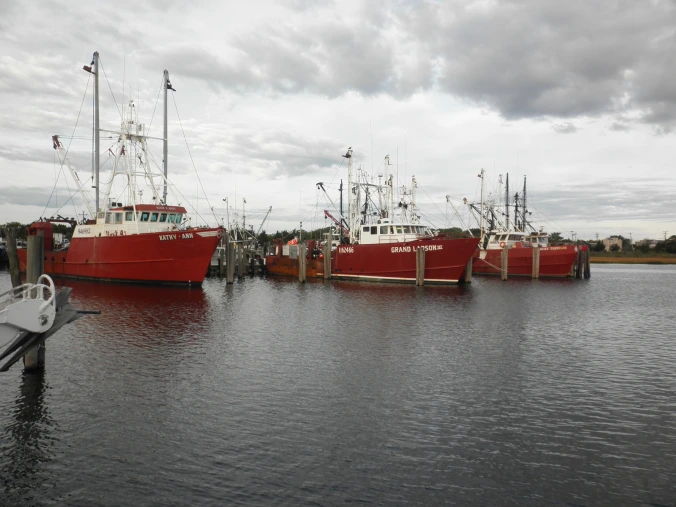
Arriving at the state park at the end of High Bar Harbor, I rigged up and set off through a cedar and bayberry canopy and emerged onto a great bay beach, referred to by locals as “the dike.”
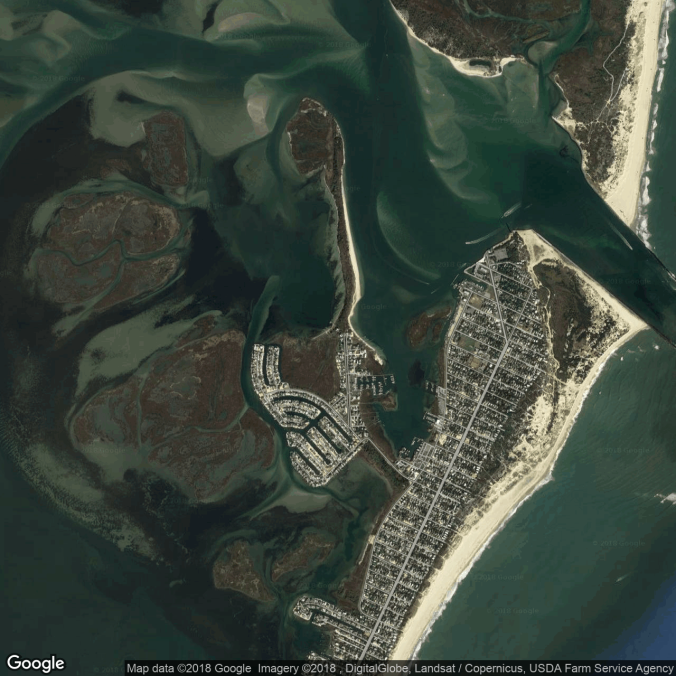
The northeast wind blew gently and immersed me in a bath of fresh salty air. Gulls and osprey soared and wheeled overhead. I had the entire beach to myself and as I walked in the sullen light of that morning, I wondered how it must have been to make a beach landing in war, the air ripped by bullets and filled with the cries of dying men.
It was a 15 minute walk to reach the end of the dike where the sod banks began. The place looked fishy and felt right. The current was flowing like a river along the banks and the water was a beautiful blue-green, reminding me that the emerald beaches of the Gulf have their own beauty but it is not the only beauty that water can have.
I found a point that protected a sandy cut behind it. It looked like a perfect place for bass and blues to set up and ambush or intercept prey.
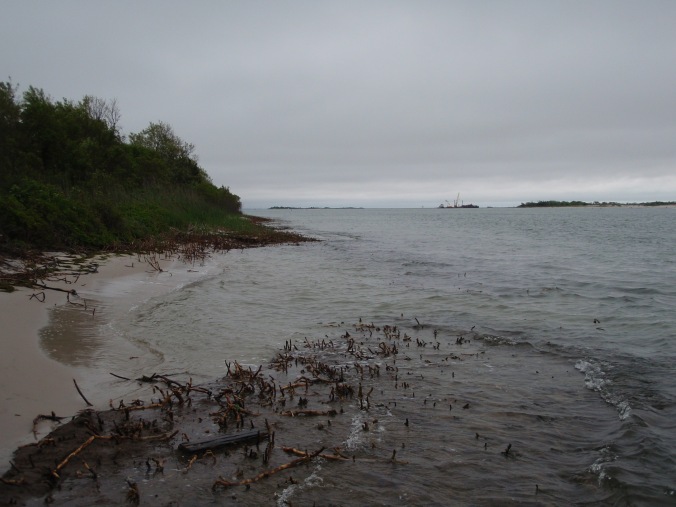
My 8 weight was rigged with an intermediate sink tip line. I tied on a 1/0 chartreuse and blue clouser. Casting slightly up-current just like I would fishing a trout river with a streamer, I let the fly sink, counted down to 10, and began to strip the fly back on the swing. On just the third such cast, the fly stopped with a solid throbbing jolt. The rod tip danced and bowed in a deep arc and I cleared the line and got the fish on the reel. What followed was a good deep fight, filled with head shakes and lunging runs…
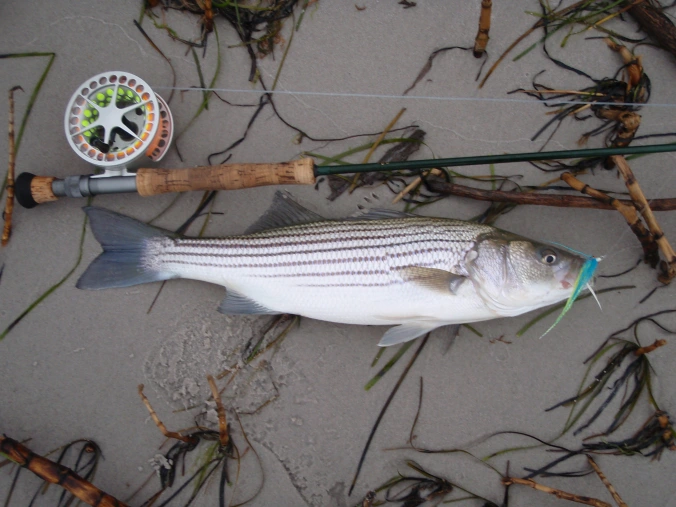
I was elated: this striper was a first on the fly and I caught it using the basics I had taught at a BC Flyfishers meeting held the week before.
I worked my way up the dike, casting and working the fly deep on the swing. The bass seemed to be holding in close, just off the current, no doubt picking up baitfish and crustaceans flushed loose from the banks by the tidal current. The bite lasted another hour during which I tallied three more nice schoolie bass…
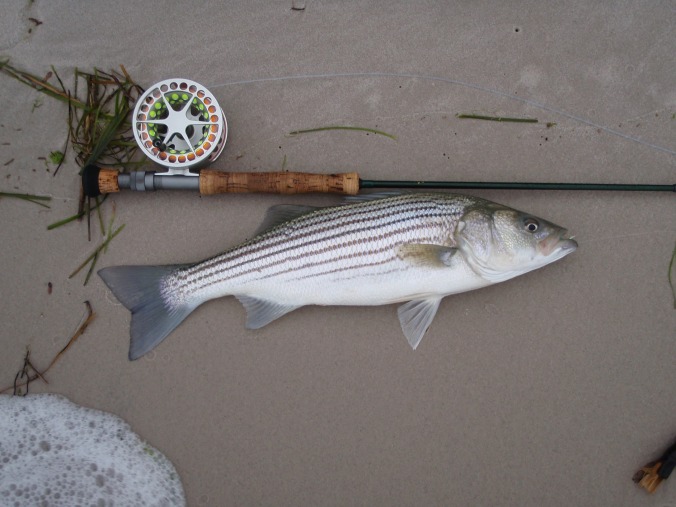
The current died when the tide reached high slack water and this lull would last a bit before the great bay had absorbed the ocean’s rush and started pushing it back seaward. I decided to pack it in, happy with my success. I had, after all, achieved one of my fly fishing goals; to catch a striped bass on the fly.
The walk and wade back was a long one. I was tired from the morning’s fishing and the soft sand underfoot made the hike all the more taxing but gave me time to once again reflect on the meaning of the day. Just before going to bed the night before, in an effort to calm my excitement over fishing the next day, I pulled out a Field & Stream anthology of short stories. The book seemed to naturally open to a story titled “Roger’s River”. The author, outdoor writer Ralph D. Conroy, was born in 1939, grew up in Massachusetts, and was an Army veteran. Mr. Conroy was a regular contributor to Guns & Ammo magazine, and was also published in Reader’s Digest and Field & Stream. In his short story, “Roger’s River”, the author writes of many themes familiar to stories with fly fishing as a backdrop, but it was the theme of connection and subsequent loss in war that resonated with me most that evening.
The story takes place during the Korean War. The author, recently graduated from high school, ventures afield in the Vermont countryside to set up camp by a river and fish alone. He is a week away from reporting for basic training in the Army and this is his last time to fish before heading off to war. He arrives at a small town and meets another young man who turns out to be a local fly fisherman familiar with a stream close by. The young man’s name is Roger. The two young men only briefly chat before Roger sets off to what the author later describes as “his river.” This is the only time the two men actually talk to one another in the story.
The author sets up camp that evening and hears the distant wail of a harmonica as he sits by his campfire. The next day he discovers Roger’s camp – neat and orderly – as he returns from fishing the river. There he finds the makings of a poem scribbled on some paper that hints that Roger too, will soon be off to war. After packing up, the author has the feeling that he is leaving more than the river behind.
Fast forward a year and the author is back home from his tour of duty in Korea. He returns to Roger’s river and finds Roger’s camp a mess – littered and in disarray. He leaves the camp on a mission to find out what may have happened to Roger. Courtesy of a local gas station attendant, he locates Roger’s house and meets his father, who reveals that his son had died in a helicopter crash in Korea a week before he was supposed to come home.
Over 54,246 men were killed during the Korean War with 7,704 still unaccounted for as of 2021. As I walked up the beach to the wood line of bayberry and cedar that marked the path out of the dike, I remembered the prose of Conroy’s story, recalling the meaning it carried, like the clarion call of taps in the evening. I thought of those lost in that war, like Roger, who may have carried a fly rod to cherished water, fished it one last time, and then left it behind for a higher calling. I stopped, took pause to view the bay, then turned and left it behind me, feeling fortunate for the morning’s fishing, but more so, for what they gave so that I could return to my own river and fish another day.
Recent Comments